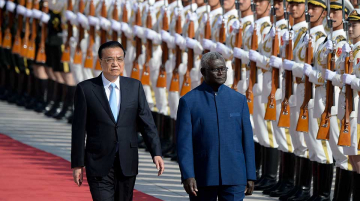
By Lukas Fiala
Occasionally, a new report reignites the debate over where China might place its next military base. And just in time for the PLA’s 96th anniversary on Tuesday this week a recent study from AidData sheds new light on the topic.
It’s obvious why we keep talking about China’s basing ambitions. Over the past two decades, China has successfully modernized the People’s Liberation Army Navy (PLAN) while reorienting the military’s focus away from ground force dominance towards joint force operations supported by advanced technologies.
However, the PLA’s dream of a blue water navy capable of sustaining longer deployments and combat operations far from China’s littoral is hardly realizable without dedicated logistics support facilities akin to the network of U.S. bases that has sustained Washington’s power projection for decades.
From China’s perspective, additional logistics facilities would fulfill two objectives. Operationally, they could support the PLA’s ability to provide security for Chinese citizens and assets abroad, a complex policy issue that Beijing has been struggling to respond to over the last decade of unprecedented economic internationalization. Strategically, they could enhance deterrence and power projection, especially when featuring long-range capabilities or supporting a growing subsurface presence beyond the Indian Ocean.
Speculations as to where China might double down on military real estate are consequently not new. And all too often claims of China’s next base have been driven by sensationalism and little concrete evidence of actual progress.
AidData’s recent report is thus a welcome intervention into existing debates as it presents one of the most systematic assessments of China’s existing infrastructure commitments that could lead to the establishment of military facilities in the not-too-distant future.
Considering China’s existing port investments and their characteristics, the strategic locations of ports, Beijing’s relationships with local political elites, and voting alignment in the UN, the study argues that Hambantota (Sri Lanka), Bata (Equatorial Guinea) and Gwadar (Pakistan) are the three most likely locations for future facilities.
Adopting a mix of deductive and inductive methods to assess both extant financial commitments and China’s likely strategic considerations is certainly necessary to derive a clearer picture of which locations are most likely to host China’s potential next base. Yet, even the best methodology can hardly forecast complex decision-making processes with certainty.
Consequently, we should perhaps also pay more attention to the one example where China actually established a permanent facility: in Djibouti. The latter was enabled by the following conditions:
- The demonstrated need for logistical support after evacuation missions in Libya (2011) and Yemen (2015) which involved PLAN vessels,
- A strong economic foothold across the wider Horn of Africa, including Djibouti’s Doraleh port and neighboring Ethiopia,
- The presence of US, French and Japanese facilities which made China’s addition less controversial.
Perhaps most importantly, China and Djibouti signed a security and defense agreement in 2014, granting the PLAN access to facilities in the country. Going forward, the signing of similar agreements might serve as an additional signpost in evaluations of China’s future basing infrastructure.
Lukas Fiala is the head of the China Foresight unit at LSE IDEAS.











